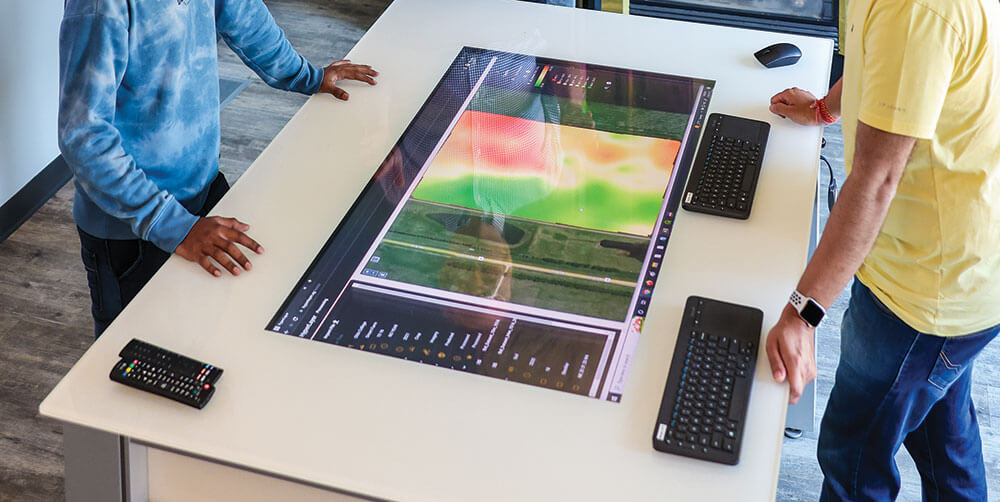Technology that excites
 JOY AGNEW moderated a Canola Discovery Forum panel on precision agriculture technology. Agnew is associate vice president, applied research, at Olds College of Agriculture & Technology in Olds, Alberta. Here are two questions she asked of her three panelists, and the panelists’ responses.
JOY AGNEW moderated a Canola Discovery Forum panel on precision agriculture technology. Agnew is associate vice president, applied research, at Olds College of Agriculture & Technology in Olds, Alberta. Here are two questions she asked of her three panelists, and the panelists’ responses.
What upcoming technology most excites you?
Bonnie Mandziak, product marketing manager with Climate FieldView: “As an agronomist, it can be a difficult decision to tell a client whether to spray a fungicide. We will usually say yes because we don’t want them to have a wreck. If we can use data and digital tools to help farmers answer spray questions – Do I spray? When should I spray? Where should I spray? – we can help them make better more informed decisions. Smarter spraying will unlock yield potential and better agronomic practices such as 4R.”
Christian Hansen, small grains corporate agronomist with John Deere: “I’m excited for Innerplant, which is a company inserting fluorescent proteins into plants that can make them signal certain stressors throughout their life cycle. While Innerplant is at a very early stage, the commercial application of this tech is limitless to help agronomists and growers make proactive decisions on their farms. It could be used to signal fields that are at high risk for disease infection, insect infestations, nutrient deficiencies or even water stress.”
Hansen fills a new role at John Deere. While local dealerships have had agronomists, he is the first corporate agronomist for Western Canada. “My job is to help bring agronomic knowledge into the design process of new hardware and software solution concepts,” Hansen says. “For example, if Deere is working on new seeding technology, it would be my role to ensure that the engineering team is aware of all the agronomic factors such as rate, soil types and nutrient requirements that the machine will encounter so that they can design the solution appropriately.”
Garth Donald, manager of agronomy with Decisive Farming by Telus Agriculture: “Hyperspectral imaging. With this technology, one will be able to identify plant diseases before the human eye can see them. That way one can be more proactive than reactive.”
Hyperspectral imaging captures wavelengths beyond visible light to show things the eye can’t see. Low earth orbit satellites, once launched, will capture these high-resolution images at a broad regional scale.
For canola growers just dipping their toe into precision solutions, what’s the technology you’d recommend?
Garth Donald: “Variable-rate application. An issue with variable-rate (VR) canola seeding is that the seed flows very easily. Can your drill adjust rates effectively? If not, VR seeding for canola is not practical. In general, with any discussion about precision tools, we don’t ask enough questions of the grower, to find out their objectives and find a system that meets the ROI they’re looking for.”
Christian Hansen: “Pulse-width modulation. If we think about the most utilized piece of equipment on the farm, the answer is the sprayer. A sprayer with the latest tech is a sound investment to ensure we are applying the intended target rate and water volume while also minimizing overlap or misses. Pulse width modulation provides product control down to the nozzle level by utilizing solenoid valves that rapidly turn themselves off and on at different frequencies to hit a target application rate. The systems are smart enough to determine the amount of pulses per second required to deliver a target rate based on nozzle size, machine speed, and pump pressure. Some systems can compensate rate when turns are made because the inner boom is moving slower than an outer boom. The system, when coupled with section control and the ability to vary rate based on prescription maps, simplifies the application process and ensures products are accurately and sustainably applied across the entire farming operation.”

Bonnie Mandziak: “On our farm the past few years we’ve moved to VR seed and fertilizer, and we’ve seen a major improvement in crop uniformity. It’s not necessarily about spending more or less, it’s about placing the nutrients where they are needed. Growers can also make use of the sprayers to reduce costs. For example, a sprayer that has individual nozzle control and VR capability connected to a digital platform can be utilized to create an on-off map for fungicide based on canola biomass. This is a really good way to reduce costs of sclerotinia stem rot management.”
For Joy Agnew, the highlight of the panel was the acknowledgment that return on investment for precision technology will differ from farmer to farmer. “This means that precision ag providers have a tough job: providing a product or service that may be used or viewed differently by each customer,” Agnew says. “Helping producers determine or calculate the potential return on investment of adopting a precision ag tech will be that much more challenging.”
Spraying with drones
THE TOPIC OF FIELD SPRAYING and spot spraying with drones came up during the precision agriculture technology panel discussion. “Can we just extend the label for products approved for aerial application? We don’t know,” says Agnew, associate vice president, applied research, at Olds College of Agriculture & Technology. Someone in the audience at Canola Week referenced Tom Wolf, owner and sprayer specialist with Agrimetrix Research & Training. Canola Digest checked in with Wolf. Agrimetrix has not initiated its own research but has been watching results from industry trials. Wolf shared the following observations:
“At this stage, it appears that drone spraying is unique and different from both traditional fixed wing and rotary wing spraying. It has to do with the speed of the machine. The slower drones are in a transition between free flight and hover, meaning their prop downwash contributes to spray deposition. This can be both good and bad – downwash can be like air assistance helping penetrate dense canopies, more than traditional aircraft. But too much downwash and the spray cloud bounces off the surface and creates drift potential. Downwash strength depends on speed, height, and payload. As a result, the operator’s decisions are critical.
The potential for spot sprays is starting to be evaluated. A spot spray of a larger wet area in a field is, of course, a slam dunk for drones. But small spot sprays, such as weed targets, are more difficult because a drone’s aerodynamics create a relatively large footprint of deposition, even with a short spray burst.
The PMRA has requested new product efficacy and drift information for drones prior to issuing a registration on a label, even if that label already has an aerial use allowed. So they are, at this stage, still treating drones as unique. It’s possible they will eventually agree that performance isn’t that different and allow a grandfathering of aerial labels, but it still depends on the registrants’ willingness to support this new use.”





